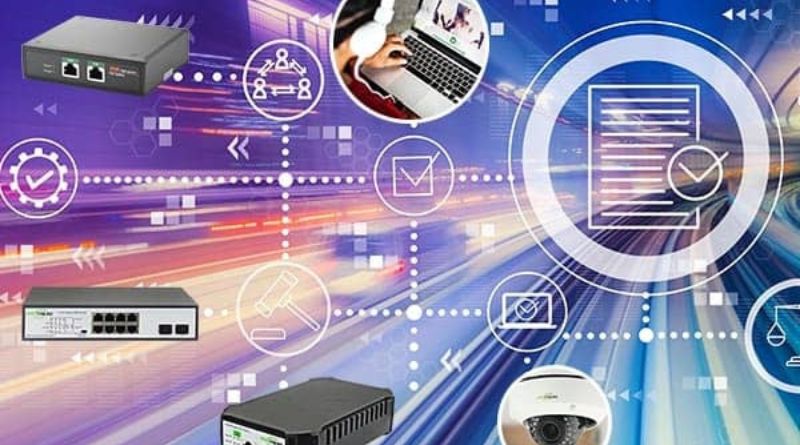What Is Power Over Ethernet (PoE)?
Power over Ethernet is a cutting-edge technology used to provide both power and data to powered devices (PDs) on a local area network (LAN) over a single Ethernet cable. PoE comes in four levels of power that are defined by the IEEE as 802.3af, 802.3at, and 802.3bt standards.
While PoE has many benefits, such as cost-saving, reliability, safety, and flexibility, it does have a major limitation: a distance limit of 100 meters (328 feet). Many LANs need to cover much larger distances (think sports venues, hotels, academic campuses, shopping malls, etc.).
The solution for this distance limitation is the PoE extender.
What Are Ethernet Extenders?
The PoE extender (sometimes called a PoE repeater) is power-sourcing equipment (PSE) that increases the distance a network can reach. This device is installed inline between the PoE switch and the PDs in the network, which significantly increases the physical distance. In fact, some PoE extenders can be “daisy-chain” multiple PDs up to 500 meters (1,640 feet).
How Does a PoE Extender Work?
A PoE extender receives power and data from the PSE (usually a PoE switch) it is connected to. The extender then uses a bit of the power it receives to operate itself (roughly four to five watts).
For example, if the PoE extender is connected to an IEEE 802.3at PSE, approximately 25 watts of power will be sent to it. It then uses five watts to operate on, leaving 20 watts of power available for the connected PoE devices (PDs). Should you daisy chain PoE extenders for further distance, each one will use five watts for itself, ultimately depleting the power supply to the PDs farther down the line.
How to Set Up a PoE Extender
Most PoE extenders are easy to set up because they are plug-and-play.
-
Set up one of your PoE extenders as a source unit.
-
Power on both units by plugging the power adapters into the wall.
-
Connect the power to one of the PoE extenders from the ethernet extender kit.
-
Plug the ethernet cable into any ports at the unit’s rear end. This cable should also connect to the PoE switch.
-
Flip the dip switch to office terminal mode or OT to set your device to operate as a source. This turns off the RT LED indication.
-
Connect your telephone cable to the wall.
-
Plug the alternate end of your telephone cable into the VDSL2 interface at the unit’s front section.
At this point, you should assemble the additional PoE extender to function as the destination unit. Flip the dip switch to Remote Terminal or RT to allow the gadget to operate as the destination. The LED RT indicator lights up.
-
Plug the ethernet cable into one of the ports at the unit’s rear.
-
Connect the adjacent side of the cable to the powered gadget, such as a wireless access point.
-
Plug your telephone cable into the VDS2 interface at the unit’s forepart. Connect the alternate side of the telephone cable to the wall. The link light flashes continuously and then stabilizes upon successful synchronization with the other unit.
PoE Extender Applications
Industrial PoE applications play a significant role in helping developers remain competitive. For instance, IP cameras and sensors allow managers to monitor manufacturing floors, especially employee behavior and automated equipment. Other PoE applications include:
-
Sensors monitor accuracy on assembly lines and eliminate wastage.
-
Improving safety compliance, thus reducing accidents at the workplace.
-
Better tracking at inventory rooms, loading blocks, and other essential areas without a direct power source.
-
Sensors also track invisible factors such as temperature changes, thus ensuring the quality of products during vulnerable development stages.
Conclusion
Upgrading your LAN with new technology can be a daunting, time-consuming, and expensive task. PoE extenders help you bypass these challenges by providing connectivity over existing ethernet cables.
Transitioning to PoE technology is cost-efficient and prolongs the lifespan of your wiring infrastructure.

